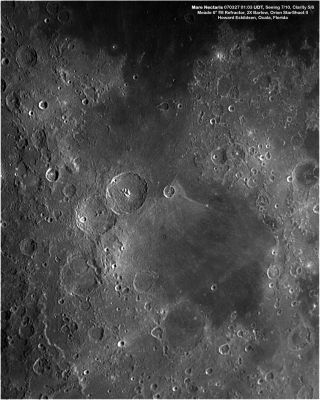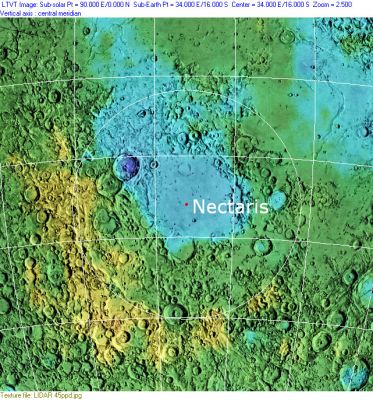Difference between revisions of "Mare Nectaris"
| Line 4: | Line 4: | ||
{| class="wiki_table" | {| class="wiki_table" | ||
| | | | ||
| − | Lat: 15.2°S, Long: 35.5°E, Diam: 333 km, Depth: km, [ | + | Lat: 15.2°S, Long: 35.5°E, Diam: 333 km, Depth: km, [[R%C3%BCkl%2058|Rükl: 58]]<br /> |
|} | |} | ||
[http://www.lpod.org/coppermine/albums/userpics/MareNectaris070327%200103em.jpg [[Image:normal_MareNectaris070327%200103em.jpg|external image normal_MareNectaris070327%200103em.jpg]]][http://www.lpod.org/coppermine/displayimage.php?pid=2344&fullsize=1 [[Image:normal_Nectaris_Basin_LIDAR_LTVT.JPG|external image normal_Nectaris_Basin_LIDAR_LTVT.JPG]]]<br /> '''Left:''' ''[http://lpod.org/coppermine/displayimage.php?pos=-1384 Howard Eskildsen]''. <br /> '''Right:''' ''[http://lpod.org/coppermine/displayimage.php?pos=-2344 Clementine]'', Clementine LIDAR Altimeter texture from [http://pdsmaps.wr.usgs.gov/PDS/public/explorer/html/lidrlvls.htm PDS Map-a-Planet] remapped to north-up aerial view by [http://www.henriksucla.dk/ LTVT]. The dot is the center position and the white circle the main ring position from Chuck Wood's [http://www.lpod.org/cwm/DataStuff/Lunar%20Basins.htm Impact Basin Database]. Grid spacing = 10 degrees.<br /> <br /> <div id="toc"> | [http://www.lpod.org/coppermine/albums/userpics/MareNectaris070327%200103em.jpg [[Image:normal_MareNectaris070327%200103em.jpg|external image normal_MareNectaris070327%200103em.jpg]]][http://www.lpod.org/coppermine/displayimage.php?pid=2344&fullsize=1 [[Image:normal_Nectaris_Basin_LIDAR_LTVT.JPG|external image normal_Nectaris_Basin_LIDAR_LTVT.JPG]]]<br /> '''Left:''' ''[http://lpod.org/coppermine/displayimage.php?pos=-1384 Howard Eskildsen]''. <br /> '''Right:''' ''[http://lpod.org/coppermine/displayimage.php?pos=-2344 Clementine]'', Clementine LIDAR Altimeter texture from [http://pdsmaps.wr.usgs.gov/PDS/public/explorer/html/lidrlvls.htm PDS Map-a-Planet] remapped to north-up aerial view by [http://www.henriksucla.dk/ LTVT]. The dot is the center position and the white circle the main ring position from Chuck Wood's [http://www.lpod.org/cwm/DataStuff/Lunar%20Basins.htm Impact Basin Database]. Grid spacing = 10 degrees.<br /> <br /> <div id="toc"> | ||
| Line 12: | Line 12: | ||
[http://www.lpod.org/coppermine/thumbnails.php?album=search&type=full&search=Mare%20Nectaris LPOD Photo Gallery] [http://www.lpi.usra.edu/resources/lunar_orbiter/bin/srch_nam.shtml?Mare%20Nectaris%7C0 Lunar Orbiter Images] [http://www.lpi.usra.edu/resources/apollo/search/feature/?feature=Mare%20Nectaris Apollo Images]<br /> [http://history.nasa.gov/ap08fj/photos/13-e/med/as08-13-2243.jpg AS08-13-2243]; which is an orbital Hasselblad photograph made during the first manned mission of Project Apollo (Apollo 8 in december 1968), shows the sunrise terminator over the western part of '''Mare Nectaris''', with the ruined crater '''Daguerre''' in the foreground (looking southward).<br /> Apollo 11's orbital photographs [http://www.lpi.usra.edu/resources/apollo/frame/?AS11-42-6235 AS11-42-6235], [http://www.lpi.usra.edu/resources/apollo/frame/?AS11-42-6236 AS11-42-6236], [http://www.lpi.usra.edu/resources/apollo/frame/?AS11-42-6237 AS11-42-6237], and [http://www.lpi.usra.edu/resources/apollo/frame/?AS11-42-6241 AS11-42-6241] show the same area of '''Mare Nectaris''' as depicted in Apollo 8's low-sun orbital view in AS08-13-2243.<br /> Research orbital Hasselblads: Danny Caes.<br /> <br /> | [http://www.lpod.org/coppermine/thumbnails.php?album=search&type=full&search=Mare%20Nectaris LPOD Photo Gallery] [http://www.lpi.usra.edu/resources/lunar_orbiter/bin/srch_nam.shtml?Mare%20Nectaris%7C0 Lunar Orbiter Images] [http://www.lpi.usra.edu/resources/apollo/search/feature/?feature=Mare%20Nectaris Apollo Images]<br /> [http://history.nasa.gov/ap08fj/photos/13-e/med/as08-13-2243.jpg AS08-13-2243]; which is an orbital Hasselblad photograph made during the first manned mission of Project Apollo (Apollo 8 in december 1968), shows the sunrise terminator over the western part of '''Mare Nectaris''', with the ruined crater '''Daguerre''' in the foreground (looking southward).<br /> Apollo 11's orbital photographs [http://www.lpi.usra.edu/resources/apollo/frame/?AS11-42-6235 AS11-42-6235], [http://www.lpi.usra.edu/resources/apollo/frame/?AS11-42-6236 AS11-42-6236], [http://www.lpi.usra.edu/resources/apollo/frame/?AS11-42-6237 AS11-42-6237], and [http://www.lpi.usra.edu/resources/apollo/frame/?AS11-42-6241 AS11-42-6241] show the same area of '''Mare Nectaris''' as depicted in Apollo 8's low-sun orbital view in AS08-13-2243.<br /> Research orbital Hasselblads: Danny Caes.<br /> <br /> | ||
==Maps== | ==Maps== | ||
| − | ([ | + | ([[LAC%20zone|LAC zone]] 79D3) ''[http://www.lpi.usra.edu/resources/mapcatalog/LAC/lac79/ LAC map] [http://www.lpi.usra.edu/resources/mapcatalog/usgs/I714/ Geologic map]''<br /> <br /> |
| − | ==[ | + | ==[[Lunar%20Basins|Basin Classification]]== |
(description of terms and most numeric basin data from Wood, C.A. (2004) [http://www.lpod.org/cwm/DataStuff/Lunar%20Basins.htm Impact Basin Database])<br /> | (description of terms and most numeric basin data from Wood, C.A. (2004) [http://www.lpod.org/cwm/DataStuff/Lunar%20Basins.htm Impact Basin Database])<br /> | ||
{| class="wiki_table" | {| class="wiki_table" | ||
| Line 34: | Line 34: | ||
<br /> | <br /> | ||
==Description: Elger== | ==Description: Elger== | ||
| − | ([ | + | ([[IAU%20Directions|IAU Directions]]) The Mare Nectaris, again, in the south-eastern quadrant, presents some fine examples of concentric ridges, which are seen to the best advantage when the morning sun is rising on [[Rosse|Rosse]], a prominent crater north of [[Fracastorius|Fracastorius]]. This "sea" is evidently concave in cross-section, the central portion being considerably lower than the margin, and these ridges appear to mark the successive stages of the change of level from the coast-line to the centre. They suggest the "caving in" of the surface, similar to that observed on a frozen pond or river, where the "cat's ice" at the edge, through the sinking of the water beneath, is rent and tilted to a greater or less degree.<br /> <br /> |
==Description: Wikipedia:== | ==Description: Wikipedia:== | ||
[http://en.wikipedia.org/wiki/Mare_Nectaris Mare Nectaris]<br /> <br /> | [http://en.wikipedia.org/wiki/Mare_Nectaris Mare Nectaris]<br /> <br /> | ||
| Line 53: | Line 53: | ||
* [http://www2.lpod.org/wiki/July_22,_2004 Huge Fractures] | * [http://www2.lpod.org/wiki/July_22,_2004 Huge Fractures] | ||
* [http://www2.lpod.org/wiki/May_4,_2004 Inside Nectaris] | * [http://www2.lpod.org/wiki/May_4,_2004 Inside Nectaris] | ||
| − | * [ | + | * [[LPOD%20Feb%204%2C%202008|Four Rings and a Mystery]] |
<br /> | <br /> | ||
==Bibliography== | ==Bibliography== | ||
Revision as of 16:03, 15 April 2018
Contents
Nectaris Basin
(unofficial name; IAU feature name for central 333 km of mare: Mare Nectaris)
|
Lat: 15.2°S, Long: 35.5°E, Diam: 333 km, Depth: km, Rükl: 58 |


Left: Howard Eskildsen.
Right: Clementine, Clementine LIDAR Altimeter texture from PDS Map-a-Planet remapped to north-up aerial view by LTVT. The dot is the center position and the white circle the main ring position from Chuck Wood's Impact Basin Database. Grid spacing = 10 degrees.
Table of Contents
[#Nectaris Basin Nectaris Basin]
[#Nectaris Basin-Images Images]
[#Nectaris Basin-Maps Maps]
[#Nectaris Basin-Basin Classification Basin Classification]
[#Nectaris Basin-Description Description]
[#Nectaris Basin-Description: Elger Description: Elger]
[#Nectaris Basin-Description: Wikipedia: Description: Wikipedia:]
[#Nectaris Basin-Additional Information Additional Information]
[#Nectaris Basin-Nomenclature Nomenclature]
[#Nectaris Basin-LPOD Articles LPOD Articles]
[#Nectaris Basin-Bibliography Bibliography]
Images
LPOD Photo Gallery Lunar Orbiter Images Apollo Images
AS08-13-2243; which is an orbital Hasselblad photograph made during the first manned mission of Project Apollo (Apollo 8 in december 1968), shows the sunrise terminator over the western part of Mare Nectaris, with the ruined crater Daguerre in the foreground (looking southward).
Apollo 11's orbital photographs AS11-42-6235, AS11-42-6236, AS11-42-6237, and AS11-42-6241 show the same area of Mare Nectaris as depicted in Apollo 8's low-sun orbital view in AS08-13-2243.
Research orbital Hasselblads: Danny Caes.
Maps
(LAC zone 79D3) LAC map Geologic map
Basin Classification
(description of terms and most numeric basin data from Wood, C.A. (2004) Impact Basin Database)
| Certainty of Existence |
USGS Age |
Wilhelms Age Group |
Ring Diameters |
Mare Thickness |
Mascon |
| Certain |
Nectarian |
10 |
240, 400, 620, 860, 1320 km |
0.8-1.2 km |
Yes; +70 mG gravity anomaly |
Description
Description: Elger
(IAU Directions) The Mare Nectaris, again, in the south-eastern quadrant, presents some fine examples of concentric ridges, which are seen to the best advantage when the morning sun is rising on Rosse, a prominent crater north of Fracastorius. This "sea" is evidently concave in cross-section, the central portion being considerably lower than the margin, and these ridges appear to mark the successive stages of the change of level from the coast-line to the centre. They suggest the "caving in" of the surface, similar to that observed on a frozen pond or river, where the "cat's ice" at the edge, through the sinking of the water beneath, is rent and tilted to a greater or less degree.
Description: Wikipedia:
Additional Information
- Mare area of 84,100 km^2 according to measurements by Jim Whitford-Stark.
Nomenclature
The IAU feature name means "Sea of Nectar".
- The impact basin is named after the mare.
LPOD Articles
- Moving West.
- Ring Around a Basin.
- A Large but Subtle Dome
- Chameleon Surface
- Huge Fractures
- Inside Nectaris
- Four Rings and a Mystery
Bibliography
- Chauhan, P. et al (2011). Studies of Lunar Dark-halo Craters in Northwestern Mare Nectaris Using High Resolution Chandrayaan-1 Data – 42nd LPSC Conference (Mar), 2011.
- Spudis, P. D.; Hawke, B. R.; Lucey, P. G. 1989. Geology and deposits of the lunar Nectaris basin. in Lunar and Planetary Science Conference, 19th, Houston, TX, Mar. 14-18, 1988, pp. 51-59.
- Wood, C.A. 20__. Rings and Things. Sky and Telescope online article
- Whitford-Stark, J.L. (1981) The evolution of the lunar Nectaris multiring basin, Icarus 48, 393-427.
This page has been edited 1 times. The last modification was made by - tychocrater tychocrater on Jun 13, 2009 3:24 pm - afx3u2//